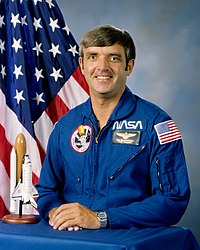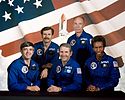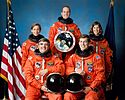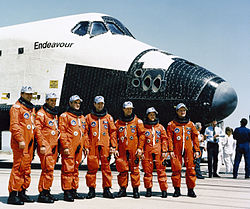Daniel Brandenstein
| Daniel Brandenstein | |
|---|---|
 | |
| Land | USA |
| Organisation | NASA |
| ausgewählt | 16. Januar 1978 (8. NASA-Gruppe) |
| Einsätze | 4 Raumflüge |
| Start des ersten Raumflugs | 30. August 1983 |
| Landung des letzten Raumflugs | 16. Mai 1992 |
| Zeit im Weltraum | 32d 21h 03min |
| ausgeschieden | 1. Oktober 1992 |
| Raumflüge | |
Daniel Charles Brandenstein (* 17. Januar 1943 in Watertown, Wisconsin) ist ein ehemaliger US-amerikanischer Astronaut.
Brandenstein erhielt 1965 einen Bachelor in Mathematik und Physik von der University of Wisconsin. Im September 1965 kam er zur US-Navy und wurde dort zum Marineflieger ausgebildet. Zwischen 1968 und 1970 war er auf den Flugzeugträgern USS Constellation und USS Ranger eingesetzt und flog insgesamt 192 Kampfeinsätze im Vietnamkrieg. Anschließend arbeitete er als Testpilot und Pilotenausbilder für die Navy.
Astronautentätigkeit
Im Januar 1978 wurde Brandenstein als Astronautenanwärter von der NASA ausgewählt. Er war Verbindungssprecher (CAPCOM) und Mitglied der Unterstützungsmannschaften für die beiden ersten Space-Shuttle-Flüge (STS-1 und STS-2). Nach seinem zweiten Raumflug im Sommer 1985 arbeitete er als stellvertretender Direktor des sogenannten Flight Crew Operations Directorate, das über die Mannschaftszusammensetzungen von Raumflügen entscheidet. Von April 1987 bis September 1992 war Brandenstein Leiter des Astronautenbüros.
STS-8
Am 30. August 1983 flog Brandenstein als Pilot der Raumfähre Challenger zum ersten Mal ins All. Diese Mission war der erste Flug eines Space Shuttle, bei dem sowohl Start als auch Landung in der Nacht erfolgten. Die Fracht bestand aus dem indischen Mehrzwecksatelliten Insat 1-B.
STS-51-G
Brandenstein flog am 17. Juni 1985 als Kommandant der Raumfähre Discovery ins All. Dabei wurden Kommunikationssatelliten für Mexiko (Morelos), die Arabische Liga (Arabsat) und die USA (AT&T Telstar) ausgesetzt. Außerdem wurde der SPARTAN-Satellit ausgesetzt und nach 17 Stunden mit dem Roboterarm wieder eingefangen.
STS-32
Mit der Raumfähre Columbia flog Brandenstein am 9. Januar 1990 die Mission STS-32. Zu den Hauptaufgaben des Fluges gehörte das erfolgreiche Aussetzen des Nachrichtensatelliten Syncom IV-F5 und das Bergen der Forschungsplattform LDEF mit dem Roboterarm.
STS-49
Vom 7. bis 16. Mai 1992 kommandierte Brandenstein den Jungfernflug der Raumfähre Endeavour. Ziel dieser Mission war es, den zwei Jahre zuvor gestarteten Kommunikationssatelliten Intelsat VI-F3 für eine Reparatur zu bergen. Erst mit dem dritten Außenbordeinsatz (EVA) konnte der Satellit schließlich von Hand eingefangen werden. Daraufhin erhielt Intelsat einen neuen Apogäumsmotor, damit er eine vorgesehene geostationäre Umlaufbahn erreichen konnte. Bei einer weiteren EVA wurden Strukturen und Werkzeuge getestet.
| Raumflüge | |||
|---|---|---|---|
Nach der NASA
Am 1. Oktober 1992 schied er aus der NASA und der Navy aus.
- 1996 wurde er Vizepräsident bei der Kistler Aerospace Corporation in Seattle
- Seit August 1999 Vizepräsident bei Lockheed Martin Space Operations in Houston
- Am 28. September 2007 wurde er Nachfolger von Richard Covey als stellvertretender Geschäftsführer und Leiter des operativen Geschäftsbereichs von United Space Alliance (USA).
Privates
Daniel Brandenstein und seine Frau Jane haben eine Tochter.
Siehe auch
Weblinks
- Biografie von Daniel Brandenstein in der Encyclopedia Astronautica (englisch)
- NASA-Biografie von Daniel Brandenstein (englisch; PDF)
- Kurzbiografie von Daniel Brandenstein bei spacefacts.de
| Personendaten | |
|---|---|
| NAME | Brandenstein, Daniel |
| ALTERNATIVNAMEN | Brandenstein, Daniel Charles |
| KURZBESCHREIBUNG | US-amerikanischer Astronaut |
| GEBURTSDATUM | 17. Januar 1943 |
| GEBURTSORT | Watertown, Wisconsin |
Auf dieser Seite verwendete Medien
STS-49 Patch
- STS-49 Endeavour, Orbiter Vehicle (OV) 105, crew insignia (logo), the official insignia of the NASA STS-49 mission, captures space flight's spirit of exploration which has its origins in the early seagoing vessels that explored the uncharted reaches of Earth and its oceans. The ship depicted on the patch is HMS Endeavour, the sailing vessel which Captain James Cook commanded on his first scientific expedition to the South Pacific. Just as Captain Cook engaged in unprecedented feats of exploration during his voyage, on Endeavour's maiden flight, its crew will expand the horizons of space operations with an unprecedented rendezvous and series of three space walks. During three consecutive days of extravehicular activity (EVA), the crew will conduct one space walk to retrieve, repair and deploy the INTELSAT IV-F3 communications satellite, and two additional EVAs to evaluate the potential Space Station Freedom (SSF) assembly concepts. The flags flying on Endeavour's masts wear the colors of the two schools that won the nationwide contest when Endeavour was chosen as the name of NASA's newest Space Shuttle: Senatobia (Mississippi) Middle School and Tallulah Falls (Georgia) School The names of the STS-49 flight crewmembers are located around the edge of the patch. They are Commander Daniel C. Brandenstein, Pilot Kevin P. Chilton, Mission Specialist (MS) Pierre J. Thuot, MS Kathryn C. Thornton, MS Richard J. Hieb, MS Thomas D. Akers, and MS Bruce E. Melnick. Each crewmember contributed to the design of the insignia.
STS-8 INSIGNIA --- The night launch of Challenger heading toward its third earth-orbital mission is featured in the official insignia for STS-8. The eighth flight of the United States Space Transportation System is represented by eight stars of the constellation Aquila, "The Eagle," Astronauts Richard H. Truly, commander; Daniel C. Brandenstein, pilot; Dale A. Gardner, Guion S. Bluford, and William E. Thornton--all mission specialists--have their sumames on the border of the insignia.
PHOTO CREDIT: NASA or National Aeronautics and Space AdministrationOfficial STS-8 crew portrait in flight suits. Seated from left to right are Daniel C. Brandenstein, pilot; Richard H. Truly, commander; and Guion S. Bluford Jr., Mission specialist. Standing from left to right are Dale A. Gardner, mission specialist; and William E. Thornton, mission specialist. Film Type: 120 mm
Shuttle mission 51-G patch
- The STS-51G insignia illustrates the advances in aviation technology in the United States within a relatively short span of the twentieth century. The surnames of the crewmembers for the Discovery's mission appear near the center edge of the circular design.
STS-32 Mission Insignia
- The STS-32 patch, designed by the five crewmembers for the January, 1990 space mission, depicts the Space Shuttle orbiter rendezvousing with the Long Duration Exposure Facility (LDEF) satellite from above and the Syncom satellite successfully deployed and on its way to geosynchronous orbit. Five stars represent the mission number with three on one side of the orbiter and two on the other. The seven major rays of the sun are in remembrance of the crewmembers for STS 51-L. In preparation for the first Extended Duration Orbiter (EDO) missions, STS-32 conducted a number of medical and middeck scientific experiments. The caduceus on the left represents the medical experiments, and the crystalline structure on the right represents the materials science. The crew is comprised of Astronauts Daniel C. Brandenstein, James D. Wetherbee, Bonnie Dunbar, Marsha S. Ivins, and G. David Low.
STS-51G Crew photo with Commander Daniel C. Brandenstein, Pilot John O. Creighton, Mission Specialists Shannon W. Lucid, John M. Fabian, Steven R. Nagel and Payload Specialists Patrick Baudry and Sultan bin Salman Al-Saud.
Five astronauts launched aboard the Space Shuttle Columbia on January 9, 1990 at 7:35:00am (EST) for the STS-32 mission. Pictured in their crew portrait, front left to right, are Daniel C. Brandenstein, commander; and James D. Weatherbee, pilot. Pictured rear left to right are mission specialists Marsha S. Ivins, G. David Low, and Bonnie J. Dunbar. Primary objectives of the mission were the deployment of the SYNCOM IV-F5 defense communications satellite and the retrieval of NASA's Long Duration Exposure Facility (LDEF).
portrait astronaut Daniel Brandenstein
The STS-49 crew members pose near Endeavour after landing. Pictured left to right are: Richard J. Hieb, mission specialist; Kevin P. Chiltin, pilot; Daniel C. Brandenstein, commander; and mission specialists Thomas D. Akers, Pierre J. Thuot, Kathryn C. Thornton, and Bruce E. Melnick.












